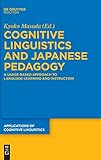Cognitive Linguistics and Japanese Pedagogy : A Usage-Based Approach to Language Learning and Instruction / ed. by Kyoko Masuda.
Material type: TextSeries: Applications of Cognitive Linguistics [ACL] ; 35Publisher: Berlin ; Boston : De Gruyter Mouton, [2018]Copyright date: ©2018Description: 1 online resource (331 p.)Content type:
TextSeries: Applications of Cognitive Linguistics [ACL] ; 35Publisher: Berlin ; Boston : De Gruyter Mouton, [2018]Copyright date: ©2018Description: 1 online resource (331 p.)Content type: - 9783110454000
- 9783110454161
- 9783110456554
- 495.6 23/eng/20231120
- PL519 .C64 2018
- online - DeGruyter
- Issued also in print.
| Item type | Current library | Call number | URL | Status | Notes | Barcode | |
|---|---|---|---|---|---|---|---|
 eBook
eBook
|
Biblioteca "Angelicum" Pont. Univ. S.Tommaso d'Aquino Nuvola online | online - DeGruyter (Browse shelf(Opens below)) | Online access | Not for loan (Accesso limitato) | Accesso per gli utenti autorizzati / Access for authorized users | (dgr)9783110456554 |
Frontmatter -- Acknowledgements -- Table of contents -- List of contributors -- Preface -- 1. Advancing cognitive linguistic approaches to Japanese language learning and instruction -- I. Usage-based and schema-based approaches to language learning and instruction -- 2. Item-based patterns in second vs. first language learners’ use of Japanese polysemous particles, ni, de and kara -- 3. The second language acquisition of challenging Japanese locative particles, ni and de: A usage-based and discourse approach -- 4. Characterizing learners’ use of passive through constructions: A corpus-driven approach -- 5. A usage-based approach to presenting the polysemous particles ni and de in JFL instruction -- 6. A comparative study of the efficacy of using image schema-based versus rule-based instruction in presenting the Japanese particles ga, o and ni with instructional videos -- II. Prototype approaches to language learning and instruction -- 7. L2 acquisition of the Japanese verbal hedge omou: A prototype approach -- 8. The effect of form-focused instruction on L2 acquisition of Japanese imperfective -teiru using prototype and traditional approaches -- 9. How to effectively teach the polysemous Japanese particle de in the classroom: Assessing the Projection Model in semantics -- III. Towards better integration of cognitive linguistics and language pedagogy -- 10. Future directions for informed language pedagogy from cognitive linguistics and sociocultural theory -- Author index -- Subject index
restricted access online access with authorization star
http://purl.org/coar/access_right/c_16ec
This volume, grounded on usage-based models of language, is an edited collection of empirical research examining how cognitive linguistics can advance Japanese pedagogy. Each chapter presents an acquisition or classroom study which focuses on challenging features and leads instructors and researchers into new realms of analysis by showing innovative views and practices resulting in better understanding and improved L2 learning of Japanese.
Issued also in print.
Mode of access: Internet via World Wide Web.
In English.
Description based on online resource; title from PDF title page (publisher's Web site, viewed 25. Jun 2024)


